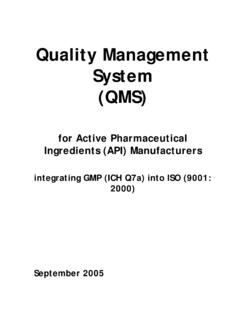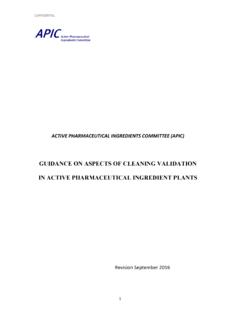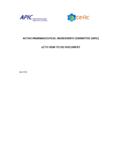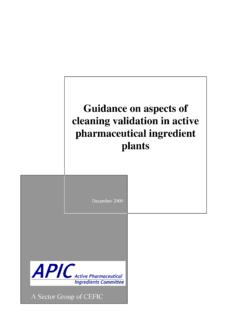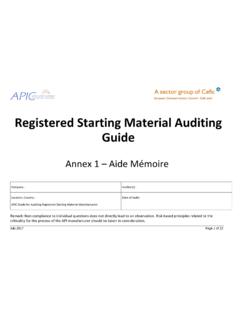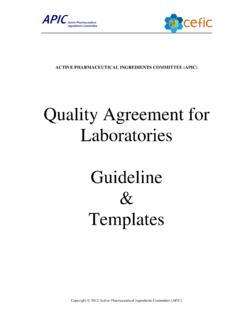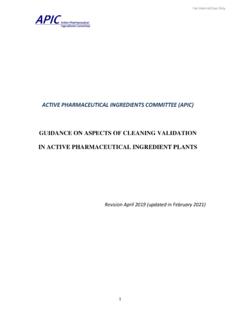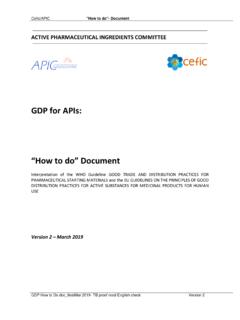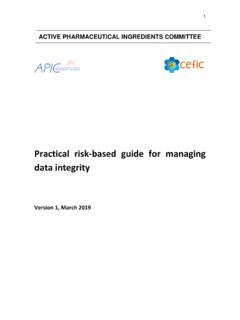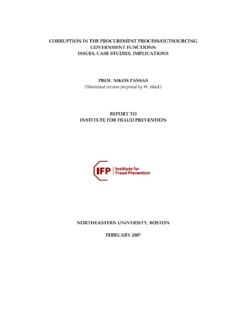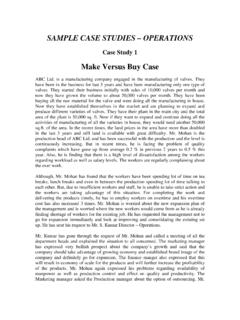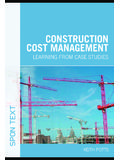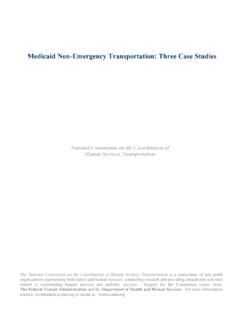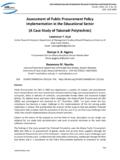Transcription of GUIDELINE for QUALIFICATION & MANAGEMENT …
1 ACTIVE PHARMACEUTICAL INGREDIENTS COMMITTEE (APIC) GUIDELINE for QUALIFICATION & MANAGEMENT of contract QUALITY CONTROL LABORATORIES 10 January 2012 2 Content 1. Introduction 2. Chapter 1: Identification of Potential Laboratories 3. Chapter 2: Risk Assessment 4. Chapter 3: Quality Assessment 5. Chapter 4: Ongoing contract Laboratory MANAGEMENT (Monitoring and Evaluation) Appendices Appendix 1: contract Laboratories Potential Identification Selection Appendix 2: contract Laboratories Questionnaires Appendix 3: Risk Assessments Tool 3 INTRODUCTION Over the last decade the pharmaceutical industry has made a dramatic shift in how it is outsourcing many activities that historically would never have been anticipated before.
2 We have seen a dramatic shift in where product and materials are manufactured and this change has also been reflected in where and how these products are tested and evaluated. To help facilitate this new environment this organisation developed guidance for Supplier MANAGEMENT and published this in January 2010. This guidance focused on supplier of materials to API manufacturers however, we also see the need to develop this guidance into phase 2 and also define guidance for Laboratory contract Life Cycle MANAGEMENT . Link to Supplier MANAGEMENT GUIDELINE : (bottom of the page) Our aim is to ensure that this guidance ensures that patients worldwide and at any time can have confidence in the quality, safety and efficacy of medicines.
3 The cGMP regulations for final medicinal products are clearly defined in each country and region. The content of the regulations may vary but the objectives are the same: - To deliver high quality, safe medicines manufactured and distributed following controlled procedures to treat diseases and - To prevent deaths, serious illnesses, adverse events or product recalls resulting from deficiencies in the manufacturing and distribution processes. It has been well documented and communicated where systems have been inadequate and in case deficient in managing the full product life cycle, resulting in patient impact and the loss of trust with our customers.
4 In the last number of years the pharmaceutical industry, and the Regulatory Authorities and inspectorates have taken action to address these deficiencies for the future. This is ensuring that appropriate cGMP practices are applied. The ever increasing infiltration of counterfeit medicines and falsified APIs into the supply chain continues to worry Regulatory Authorities and Industry at large and serves as a constant threat to the patients. It is therefore essential that we qualify and manage the entire supply chain for medicines and all other inputs to this process. The scope of this guidance document is to share the best practices of APIC member companies on systems to be implemented to adequately manage contact laboratories through the complete life cycle of the product, including Identification of Potential Laboratories Risk Assessment Quality Assessments Ongoing Supplier MANAGEMENT (Monitoring and Evaluation) Our guidance covers Laboratory MANAGEMENT over the entire product lifecycle as described in the contract Laboratory MANAGEMENT Flow Chart below.
5 4 Identification of Potential Laboratories Potential Business Visit to Evaluate FacilitiesRecommendationsGo/No GORisk Assessment Remediation and Assessment of the RemediationApproval under change controlYes/NoPotential for Paralel testingLaboratory Approval/QualificationYes/NoOngoing Monitoring & Evaluation Signed Quality/ contract Agreements Laboratory Selection ProcessShort ListData Collection from the LaboratoriesQuality Agreement DevelopmentHigh Impacting Data/ResultsAll LaboratoriesKey to Colour CodesContract Laboratory MANAGEMENT across the Life CycleMethod Transfer & ValidationContract DevelopmentQuality AssessmentInitial Evaluation of Test Result for High Risk Laboratories 5 In the appendices we also provide specific assessment documents as examples to help with contact laboratory evaluation based on best practice sharing by the Task Force members as listed below: contract Laboratories Potential Identification Selection contract Laboratories Questionnaires Risk Assessments Tool The target audience for the guidance document is primarily API Manufacturers while it may also be used by medicinal product manufacturers.
6 Based on the complexity of testing there should be increasing Levels of GMP applied to assess the risk to patients and we recommend that companies follow ICH Q9 for their Quality Risk MANAGEMENT process and use the ICH Q9 definition of Risk:- Risk is the combination of the probability of occurrence of harm and the severity of the harm to the patient or consumer . The contract Laboratories must be approved using the Company s Change Control Procedures. Guidance: The quality system requirements for contract Laboratories must follow the full life cycle MANAGEMENT for identification, selection, approval, QUALIFICATION and ongoing monitoring and evaluation.
7 In some cases we have seen that Regulatory Agencies has taken the approach to inspect some contract Laboratory Companies and this has been well documented, however this does not mean that Pharmaceutical Companies can rely on these spot inspections. It is still our responsibility to manage the oversight and ensure that testing being completed is as per the cGMPs as outlined in the Quality Agreements developed. Having a team selection process would appear to be a best practice and to have this take place in the early part of the evaluation process is very helpful to project timing and this approach is outlined. The Quality Assessment is a critical step and should be carried out before any Quality Agreement is put in place.
8 With this evaluation the level of risk can be assessed and some mitigating steps can be outlined and agreed through the Quality Agreement. Any other issues that arise during the laboratory assessment should be addressed by the selection team. Template documents for both the Quality Assessment and the Risk Assessment can be found in the Appendices to give detailed guidance. The decision to audit or not audit of a contract Laboratory must be based on a documented Risk Assessment and if deemed necessary this audit must be completed before any testing that is performed by the laboratory and then at a frequency in line with the ongoing evaluation and risk.
9 For any new testing methods transfer and validation must be considered and the outcome documented. 6 If the specifications for the test results are communicated to the contract laboratory by the contract giver then an OOS procedure must be in place, and in the event of an out of specification result an investigation must be completed and documented by the laboratory. The main steps of Laboratory MANAGEMENT are described in each chapter but we should also reference existing APIC guidance documents which are very much applicable to further clarify expectations and provide consistency to the processes.
10 : - Quality Agreements - Auditing Guide, - APIC Audit Programme - APIC Quick Guide for API Sourcing - APIC ICHQ7 How to do Document - APIC Quality MANAGEMENT System Guide for API manufacturers These documents are available on the APIC website: WWW. In the appendices we also provide specific assessment documents as examples to help with supplier evaluation based on best practice sharing by the Task Force members listed below: - Buggy Tom (DSM ANTI-INFECTIVES) - Stilgenbauer-Voigt Ingrid (BASF) - Vandeweyer Fran ois (JANSSEN PHARMACEUTICA) - Counihan Eileen, Chair (MERCK SHARP & DOHME) - Storey Anthony (PFIZER) - Macedo Maria Jos (Hovione FarmaCiencia SA) - Genot V ronique (Abbott Healthcare Products ) We hope you will find the content of this guidance and the templates useful in the evaluation and MANAGEMENT of contract laboratories ensuring safe APIs and medicines for the health, safety and quality of life of our patients worldwide.
